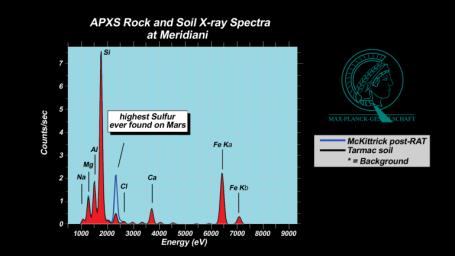
|
“McKittrick” Rich in Sulfur
- Click the image above for a larger view
- Full-Res JPEG (1920 x 1080) (137.5 kB)
- Full-Res TIFF (1920 x 1080) (546.9 kB)
Caption:
These plots, or spectra, show that a rock dubbed "McKittrick" near the Mars Exploration Rover Opportunity's landing site at Meridiani Planum, Mars, possesses the highest concentration of sulfur yet observed on Mars. These data were acquired with the rover's alpha particle X-ray spectrometer, which produces a spectrum, or fingerprint, of chemicals in martian rocks and soil. This instrument contains a radioisotope, curium-244, that bombards a designated area with alpha particles and X-rays, causing a cascade of reflective fluorescent X-rays. The energies of these fluorescent X-rays are unique to each atom in the periodic table, allowing scientists to determine a target's elemental composition.
The spectra shown here are taken from "McKittrick" and a soil patch nicknamed "Tarmac," both of which are located within the small crater where Opportunity landed. "McKittrick" measurements were acquired after the rover drilled a hole in the rock with its rock abrasion tool. Only portions of the targets' full spectra are displayed. The data are expressed as X-ray intensity (linear scale) versus energy. The measured area is 28 millimeters (1 inch) in diameter.
When comparing two spectra, the relative intensities at a given energy are proportional to the elemental concentrations, however these proportionality factors can be complex. To be precise, scientists extensively calibrate the instrument using well-analyzed geochemical standards.
Both the alpha particle X-ray spectrometer and the rock abrasion tool are located on the rover's instrument deployment device, or arm.
Cataloging Keywords:
| Name | Value | Additional Values |
|---|---|---|
| Target | Mars | |
| System | ||
| Target Type | Planet | |
| Mission | Mars Exploration Rover (MER) | Mars Science Laboratory (MSL) |
| Instrument Host | Opportunity (MER-B) | Curiosity Rover |
| Host Type | Rover | |
| Instrument | Alpha Particle X-Ray Spectrometer (APXS) | Rock Abrasion Tool (RAT) |
| Detector | ||
| Extra Keywords | Color, Crater | |
| Acquisition Date | ||
| Release Date | 2004-03-02 | |
| Date in Caption | ||
| Image Credit | NASA/JPL/Cornell/Max Planck Institute | |
| Source | photojournal.jpl.nasa.gov/catalog/PIA05468 | |
| Identifier | PIA05468 | |
